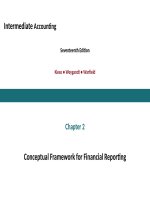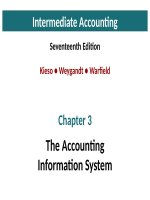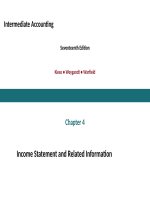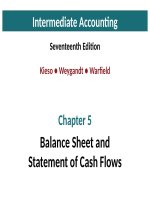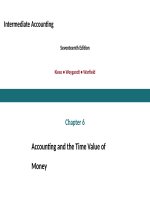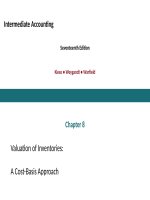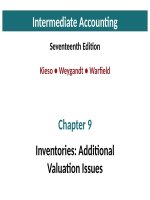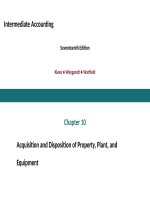Intermediate accounting 17e by kieso ch01
Bạn đang xem bản rút gọn của tài liệu. Xem và tải ngay bản đầy đủ của tài liệu tại đây (1.07 MB, 56 trang )
Intermediate Accounting
Seventeenth Edition
Kieso ● Weygandt ● Warfield
Chapter 1
Financial Accounting and
Accounting
Standards
This slide deck contains animations. Please disable animations if
they cause issues with your device.
Learning Objectives
After studying this chapter, you should be able to:
1. Describe the financial reporting environment.
2. Identify the major policy-setting bodies and their role
in the standard-setting process.
3. Explain the meaning of generally accepted accounting
principles (GAAP) and the role of the Codification for
GAAP.
4. Describe major challenges in the financial reporting
environment.
Copyright ©2019 John Wiley & Sons, Inc.
2
Preview of Chapter 1
Financial Accounting and Accounting Standards
Financial Reporting Environment
• Accounting and capital allocation
• Objective of financial reporting
• Need to develop standards
Parties Involved in Standard-Setting
• Securities and Exchange Commission
• American Institute of CPAs
• Financial Accounting Standards Board
Copyright ©2019 John Wiley & Sons, Inc.
3
Preview of Chapter 1
Financial Accounting and Accounting Standards
Generally Accepted Accounting Principles
• FASB Codification
Major Challenges in Financial Reporting
• Political environment
• Expectations gap
• Financial reporting issues
• International accounting standards
• Ethics
Copyright ©2019 John Wiley & Sons, Inc.
4
Learning Objective 1
Describe the Financial Reporting
Environment
LO 1
Copyright ©2019 John Wiley & Sons, Inc.
5
Financial Reporting Environment
Essential characteristics of accounting are:
(1) the identification, measurement, and
communication of financial information about
(2) economic entities to
(3) interested parties.
LO 1
Copyright ©2019 John Wiley & Sons, Inc.
6
Financial Reporting Environment
Economic Entity
Financial Statements
Additional Information
Financial
Financial
Information
Information
Balance Sheet
President’s
President’s letter
letter
Income
Income Statement
Statement
Prospectuses
Prospectuses
Statement
Statement of
of Cash
Cash
Flows
Flows
Reports
Reports filed
filed with
with
governmental agencies
Statement
Statement of
of Owners’
Owners’
or
or Stockholders’
Stockholders’ Equity
Equity
News
News releases
releases
Note
Note Disclosures
Environmental
Environmental impact
impact
statements
statements
GAAP
Etc.
Etc.
Accounting?
Accounting?
Identifies
Identifies
and
and
Measures
Measures
and
and
Communicates
Communicates
LO 1
Copyright ©2019 John Wiley & Sons, Inc.
Forecasts
Forecasts
7
Financial Reporting Environment
Review Question
What is the purpose of information presented in notes to the
financial statements?
a. To provide disclosure required by generally accepted
accounting principles.
b. To correct improper presentation in the financial
statements.
c. To provide recognition of amounts not included in the
totals of the financial statements.
d. To present management’s responses to auditor comments.
LO 1
Copyright ©2019 John Wiley & Sons, Inc.
8
Financial Reporting Environment
Review Question Answer
What is the purpose of information presented in notes to the
financial statements?
a. To provide disclosure required by generally accepted
accounting principles.
b. To correct improper presentation in the financial
statements.
c. To provide recognition of amounts not included in the
totals of the financial statements.
d. To present management’s responses to auditor comments.
LO 1
Copyright ©2019 John Wiley & Sons, Inc.
9
Financial Reporting Environment
Accounting and Capital Allocation
Resources are limited. Efficient use of resources often
determines whether a business thrives.
LO 1
Copyright ©2019 John Wiley & Sons, Inc.
10
Accounting and Capital Allocation
Review Question
An effective process of capital allocation is critical to a
healthy economy, which
a. promotes productivity.
b. encourages innovation.
c. provides an efficient and liquid market for buying
and selling securities.
d. All of the above.
LO 1
Copyright ©2019 John Wiley & Sons, Inc.
11
Accounting and Capital Allocation
Review Question
An effective process of capital allocation is critical to a
healthy economy, which
a. promotes productivity.
b. encourages innovation.
c. provides an efficient and liquid market for buying
and selling securities.
d. All of the above.
LO 1
Copyright ©2019 John Wiley & Sons, Inc.
12
Financial Reporting Environment
Objectives of Financial Reporting
Provide financial information about the reporting entity
that is useful to
• present and potential equity investors,
• lenders, and
• other creditors in making decisions about providing
resources to the entity.
LO 1
Copyright ©2019 John Wiley & Sons, Inc.
13
Objective of Financial Accounting
General-Purpose Financial Statements
• Provide financial reporting information to a wide
variety of users
• Provide the most useful information possible at the
least cost
Equity Investors and Creditors
• Primary users for general-purpose financial
statements
LO 1
Copyright ©2019 John Wiley & Sons, Inc.
14
Objective of Financial Accounting cont.
Entity Perspective
• Companies viewed as separate and distinct from
their owners
Decision-Usefulness
Investors are interested in assessing the company’s
1. ability to generate net cash inflows and
2. management’s ability to protect and enhance the
capital providers’ investments.
LO 1
Copyright ©2019 John Wiley & Sons, Inc.
15
The Need to Develop Standards
Financial Statements
Various users
need financial
information
••
••
••
••
••
The accounting profession
has attempted to develop a
set of standards that are
generally accepted and
universally practiced.
LO 1
Balance
Balance Sheet
Sheet
Income
Income Statement
Statement
Statement
Statement of
of Stockholders’
Stockholders’ Equity
Equity
Statement
Statement of
of Cash
Cash Flows
Flows
Note
Note Disclosure
Disclosure
Generally Accepted
Accounting Principles
(GAAP)
Copyright ©2019 John Wiley & Sons, Inc.
16
Learning Objective 2
Identify the Major Policy-Setting Bodies and
Their Role in the Standard-Setting Process
Copyright ©2019 John Wiley & Sons, Inc.
17
Parties Involved in Standard Setting
Three organizations:
• Securities and Exchange Commission (SEC)
• American Institute of Certified Public Accountants
(AICPA)
• Financial Accounting Standards Board (FASB)
LO 2
Copyright ©2019 John Wiley & Sons, Inc.
18
Parties Involved in Standard Setting
Securities and Exchange Commission (SEC)
• Established by federal government
• Securities Act of 1933 and 1934
• Accounting and reporting for public companies
• Encouraged private standard-setting body
• SEC requires public companies to adhere to GAAP
• SEC Oversight
• Enforcement Authority
LO 2
Copyright ©2019 John Wiley & Sons, Inc.
19
Parties Involved in Standard Setting
American Institute of Certified Public Accountants
(AICPA)
• National professional organization
• Established the following:
Committee on Accounting Procedures
• 1939 to 1959
• Issued 51 Accounting Research Bulletins (ARB s)
• Problem-by-problem approach failed
LO 2
Copyright ©2019 John Wiley & Sons, Inc.
20
Parties Involved in Standard Setting
American Institute of Certified Public
Accountants (AICPA)
• National professional organization
• Established the following:
Accounting Principles Board
• 1959 to 1973
• Issued 31 Accounting Principle Board Opinions (APBOs)
• Wheat Committee recommendations adopted in 1973
LO 2
Copyright ©2019 John Wiley & Sons, Inc.
21
Parties Involved in Standard Setting
Financial Accounting Standards Board (FASB)
Wheat Committee’s recommendations resulted in FASB.
Differences between FASB and APB include:
• Smaller Membership
• Full-time, Remunerated Membership
• Greater Autonomy
• Increased Independence
• Broader Representation
LO 2
Copyright ©2019 John Wiley & Sons, Inc.
22
Financial Accounting Standards Board
(1 of 3)
Organizational Structure for Setting Accounting
Standards
Financial Accounting Foundation
Purpose: To select members of the FASB and their
Advisory Councils, fund their activities, and exercise
general oversight.
LO 2
Copyright ©2019 John Wiley & Sons, Inc.
23
Financial Accounting Standards Board
(2 of 3)
Organizational Structure for Setting Accounting
Standards
Financial Accounting Standards
Board (FASB)
Purpose: To establish and improve
standards of financial accounting and
reporting for the guidance and
education of the public, including
issuers, auditors, and users of financial
information.
LO 2
Copyright ©2019 John Wiley & Sons, Inc.
Staff and Task
Forces
Purpose: To assist
Board on reporting
issues by performing
research, analysis, and
writing functions.
24
Financial Accounting Standards Board
(3 of 3)
Organizational Structure for Setting Accounting
Standards
Financial Accounting Standards Advisory
Council (FASAC)
Purpose: To consult on major policy issues, technical
issues, project priorities, and selection and organization
of task forces.
LO 2
Copyright ©2019 John Wiley & Sons, Inc.
25
